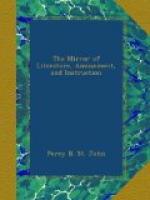The Diamond District of the Serro do Frio is about twenty leagues in length, and nine in breadth; the soil is barren, but intersected by numerous streams. It was first discovered by some miners, shortly after the establishment of the Villa do Principe. In working for gold in the rivulets of Milho Verde and St. Goncalzes, they discovered some pebbles of geometric form, and of a peculiar hue and lustre. For some years these pebbles were given as pretty baubles to children, or used as counters for marking the points of their favourite game of voltarete. At last an officer, who had been some years at Goa, in the East Indies, arrived in the Commarca: he was struck with the peculiar form of these pebbles, and from several experiments he made, it struck him that they were diamonds. He immediately collected a few, and sent them to Holland, where, to the astonishment of the lapidaries, they were found to be brilliants of the finest water. It will easily be imagined, that on the arrival of this intelligence in Brazil, the hitherto despised counters suddenly became the objects of universal research, and almost immediately disappeared.
The government of Portugal now issued a decree, declaring all diamonds a monopoly of the crown. For a length of time it was considered that diamonds were confined solely to the district of Serro Frio. But this is an error; they are found in almost every part of the empire, particularly in the remote provinces of Goyazes and Matto Grosso, where there exist several districtos diamantescos. These gems have been even found on the tops of the highest mountains; indeed, it is the opinion of the Brazilian mineralogists that the original diamond formations are in the mountains, and that they will one day or other be discovered in such quantities, as to render them objects of comparatively small value.
The largest diamond in the world was found in the river Abaite; about ninety-two leagues to N.W. of Serro do Frio. The history of its discovery is romantic:—three Brazilians, Ant. de Souza, Jose Felix Gomes, and Thomas de Souza, were sentenced, for some supposed misdemeanour, to perpetual banishment in the wildest part of the interior. Their sentence was a cruel one; but the region of their exile was the richest in the world; every river rolled over a bed of gold, every valley contained inexhaustible mines of diamonds. A suspicion of this kind enabled these unfortunate men to support the horrors of their




